March 26, 2018, by Kathryn Steenson
Wish You Were Here
British Summer Time is here and the sun is shining – for the moment, anyway – and many people are looking forward to getting away for a short break over Easter, or a longer one in the summer.
Prior to the twentieth century, holidays were the preserve of the upper classes. Overseas travel was prohibitively expensive for anyone except the rich. In the 17th century, the aristocratic ‘Grand Tour’ was firmly established as a means of finishing a wealthy young man’s education, and often took several years to complete. The places visited were mostly in Western Europe. Although travel outside Europe was possible, the difficulty and expense involved meant that it was rarely undertaken for leisure before the end of the 19th century. During the Victorian period modern tourism as a popular phenomenon emerged. For the middle-classes, travel around the UK was common and a trip abroad (of a couple of weeks, rather than a couple of years) was an achievable goal.
It has only been relatively recently that the opportunity for travel has been extended to the working classes. During the Industrial Revolution it was usual for adults to work 12 to 16 hour shifts, six days a week. Those who wanted time off did not get paid, leaving the worst off unable to afford to stop working. Four Bank Holidays were introduced in 1871, and some private companies had introduced leave entitlements for staff, it wasn’t until the Holiday Pay Act 1938 that most workers were guaranteed one week (six days) of paid annual leave.
Italy was a popular location: its beautiful art, breath-taking scenery, and Classical archaeological sites capturing the imagination of generations of travellers. From the 18th century, businesses and tradesmen used business cards to promote a wide variety of goods and services. These trade cards were the precursor to the modern advertising postcard, which, as on the front of this one, were intended to be as attractive as they were informative. The details of the business were printed on the reverse. Advertising postcards became very popular with collectors, in much the same way as the usual tourist postcards did.
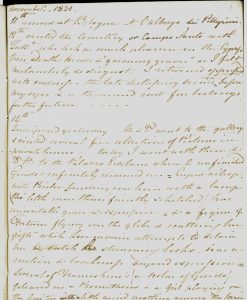
Journal of Catherine Anderson Louisa Tisdall (1796-1882), describing her trip to Europe with her family; 1820-1821. Ref: ACC 2606 MS 957
Most travellers wanted to preserve their memories in some form or other. The rich bought works of art and expensive books to decorate their mansions. Others purchased cheaper engravings, compiled scrap books of postcards, and kept diaries. This is the second of four diaries recording the trip to the continent of Catherine Tisdall with her brother James and mother Catherine. This journal begins 11th November 1820 with their arrival in Bologna, Italy, visit to a cemetery (‘melancholy’) and the Palazzo Hercolani (‘infinitely charmed’). The diary provides details of visits to galleries, social occasions, her half-brother’s wedding in Florence, her father’s illness and medical treatment, and current events such as the march of 5,000 Austrian troops to Naples to put down an insurrection.
By the end of the 1930s, the number of privately-owned cars in the UK stood at 2 million. Manufacturers began marketing them as part of a middle-class lifestyle, producing better-looking models that could travel at 70mph (safety wasn’t a particular concern yet). The red open-topped touring car travelling along a wooded road on the cover evoked images of driving holidays as freedom to explore and take in the healthy country air, rather than the modern experience of sitting in traffic jams. These guides were produced to help motorists plan this new type of holiday. It is marked as Section G, covering the Norfolk, Suffolk and Essex area, with the rest of the country covered in other sections.

Photo of museum in Cluny, from album of European travel photographs collected by Carrie S. North c.1891
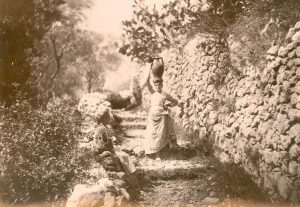
Two local women in Capri, from the album of European travel photographs collected by Carrie S North; c.1891. Ref: MS 183
By the 1880s, photographs and postcards were well-established types of souvenir. The images of museum in Cluny, France; the Barbarossa Castle in Capri, Italy; and two women carrying water in Capri, were presumably purchased from souvenir shops or taken from published guides of the places concerned. Although no dates are given the style of the photographs dates from c.1880-1900. Not much is known about the album’s owner, but in 1891, Carrie Sarah North married William Bradwell in Nottingham. The photograph album may therefore be a record of their honeymoon.
The bill is for the first few nights of a two-month trip around Germany, Switzerland and France undertaken by Henry Pelham-Clinton, 4th Duke of Newcastle under Lyne when he stayed at the Prince Charles Hotel, Germany in September-October 1846. It includes the sort of items you would expect: lodgings, meals, and transport – in this case, care of the horses and carriage. Bills were often decorative and this one has a picture of the hotel on the front and a map of the Rhine on the reverse.
The original records are held in Manuscripts & Special Collections. To find out more about our collections, including those relating to travel or tourism, or to access our collections, please contact us on mss-library@nottingham.ac.uk
No comments yet, fill out a comment to be the first

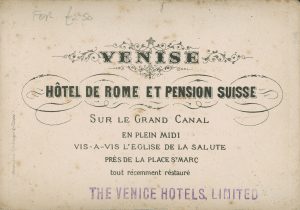

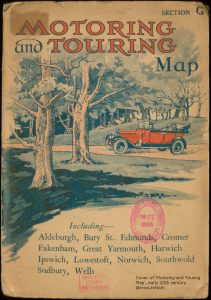
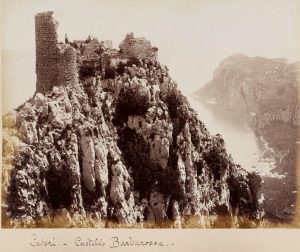

Leave a Reply